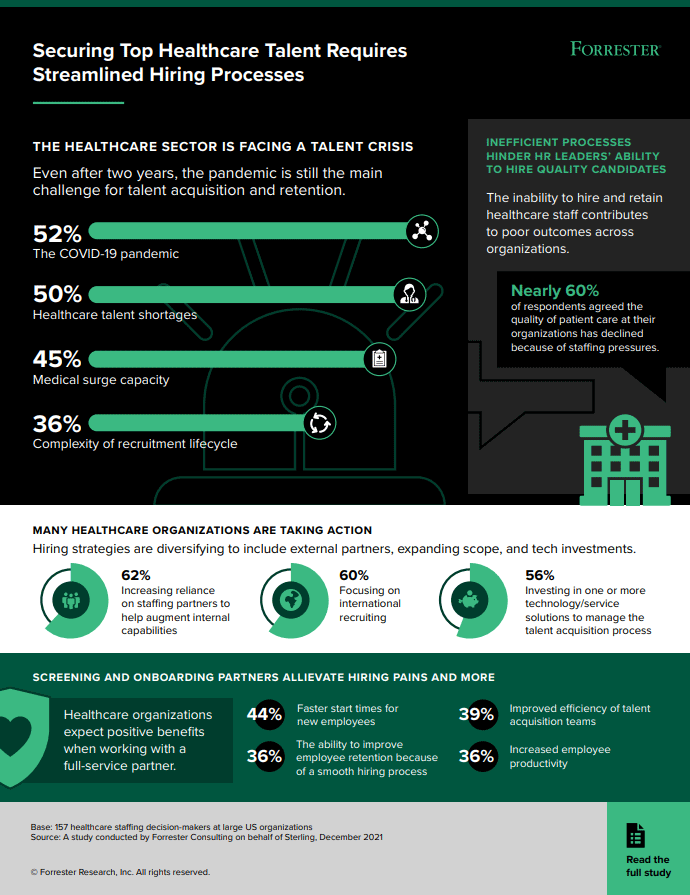July 5th, 2022 | Sterling
Top Actions for Addressing Staffing and Onboarding Issues in Healthcare

For the first time since 2004, hospital labor shortages have replaced financial challenges as the top concern for hospitals in 2021, based on data from the American College of Healthcare Executives (ACHE).
Healthcare organizations were strained to their limits during the start of the pandemic, and in 2022, its effects are still persistent. Witnessing higher rates of turnover, an increase in worker burnout, and competition with larger organizations in the non-clinical space, talent acquisition teams are taking immediate action to rectify this issue.
Sterling’s healthcare background check division recently commissioned a study with Forrester Consulting to better understand what actions healthcare HR leaders were taking to alleviate these widespread staffing and onboarding issues. Below we highlight key figures emerging from the study.
(This study included 157 HR decision-makers at large US healthcare organizations and was released in April 2022.)
The Pandemic Remains the Biggest Challenge for Talent Acquisition and Retention Teams
Healthcare employment declined at the onset of the Covid-19 pandemic in early 2020 and remains below expected levels through November 2021, a new Kaiser Family Foundation chart collection shows.
When asking our survey respondents what they consider to be their biggest challenge for talent acquisition and retention, 52% reported that Covid-19 remained the primary challenge. Following that were healthcare talent shortages (50%), medical surge capacity (45%), and complexity of the recruitment lifecycle (36%). Although staffing shortages and medical surge capacity are issues which can be beyond an organization’s control, HR teams can simplify the recruitment lifecycle in several actionable ways.
Keeping the application process simple and easy-to-understand will pique your candidate’s interest and potentially prevent them from dropping out. Leveraging user-friendly technology, such as a dedicated mobile portal, can further enhance your recruitment process. After all, 61% of all job applications were submitted via mobile devices in 2020, surpassing desktop submissions. Integrating a background check provider like Sterling into your existing ATS can streamline the overall recruiting process and efficiently identify quality talent all in one place.
Hiring Strategies Are Diversifying to Include External Partners, International Recruiting, and Investing in Tech
We mentioned in an earlier blog post on strategies for recruiting healthcare talent that healthcare labor shortages have been dominant in entry-level roles, specifically non-clinical roles. A poll by the Medical Group Management Association reported that more than 60% of medical practice leaders said their organizations have experienced a shortage of qualified applicants from non-clinical positions in the past year.
When we asked our survey respondents what actions they were taking to address staffing and onboarding issues, many respondents (62%) noted that their organizations were increasing their reliance on staffing partners who offer comprehensive solutions to help enhance internal capabilities.
60% of respondents also said they were focusing their attention on international recruiting, while another 56% noted that they were investing in one or more technology/service solutions to manage the talent acquisition process.
Recruiting internationally not only widens an organization’s talent pool, but can contribute to a diverse and fulfilling culture for all employees. However, it’s critical to have a partner that can accommodate a global background check and stay on top of both compliance updates and regional regulatory changes.
Healthcare Organizations Expect Positive Benefits With a Screening and Onboarding Partner
With many background check solutions available on the market, it’s important to understand what key benefits healthcare HR decision-makers expect to achieve when seeking a screening partner.
Faster start times for employees was the primary expected benefit that our survey respondents reported on (44%). A large portion of these benefits centered on the candidate experience both pre- and post-hire, including improving employee retention due to a smooth hiring process (36%) and increasing employee productivity (36%).
Likewise, a negative candidate experience can have an equally direct impact on a healthcare organization’s reputation. A 2021 Candidate Experience Report found that 37% of candidates have left a negative review online after having a negative experience.
On the other hand, having a candidate experience strategy in place can improve the recruiting and onboarding processes. Benefits can range from having more applicants, increasing brand awareness, and even hiring candidates faster than industry competitors. In fact, 40% of candidates reject offers because another employer gave them an offer faster, according to research from Top Echelon Network.
Conclusion
Developing these creative strategies to attract and retain top talent will continue to stay top of mind for talent acquisition and retention teams. However, these initiatives will need the support of advanced healthcare-specific screening and onboarding tools that can get candidates screened quickly and compliantly.
To view the full study, click here.
Sterling is not a law firm. This publication is for informational purposes only and nothing contained in it should be construed as legal advice. We expressly disclaim any warranty or responsibility for damages arising out this information. We encourage you to consult with legal counsel regarding your specific needs. We do not undertake any duty to update previously posted materials.


